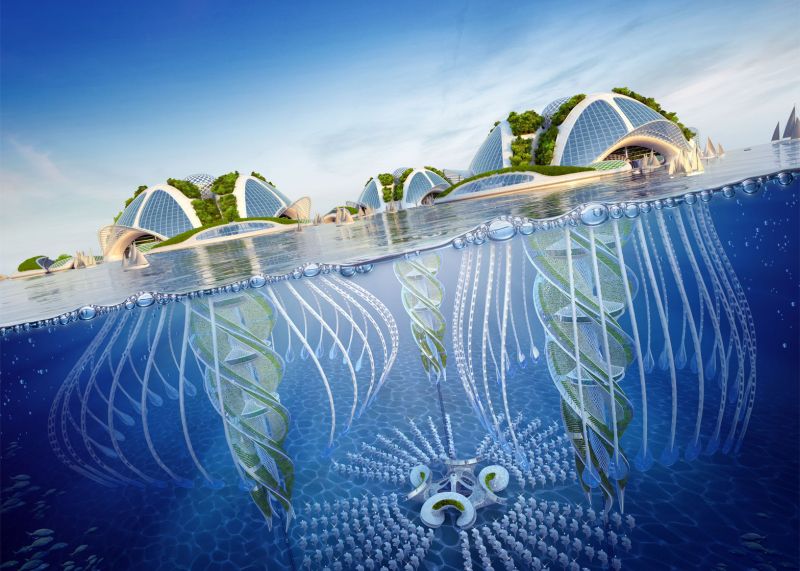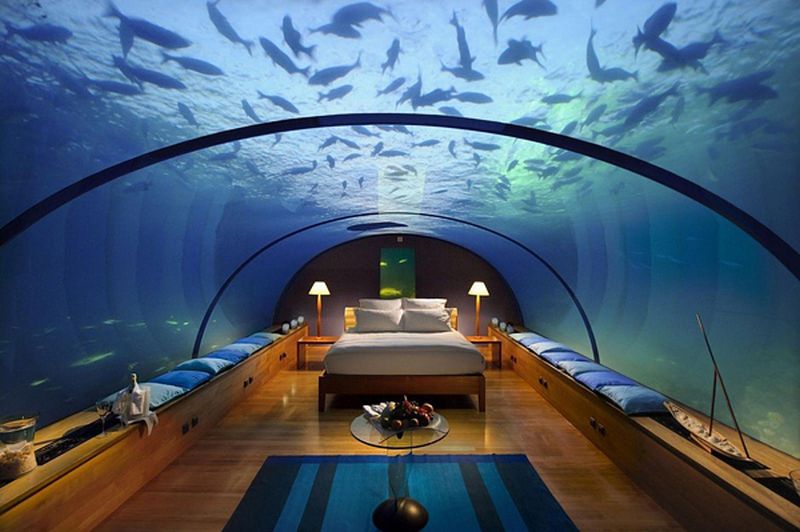The future habitat of human beings would be underwater, either due to calamity or by choice. Human imagination is fascinated with the ocean and living underneath the water. Architects now are planning homes and villages for people to live in the future, beneath the swirling waters of the seas and oceans. It might become a necessity in the future, with the glaciers melting due to global warming. The entire earth might be covered with a huge expanse of water, swallowing up land. So, these underwater house concepts may not be as futuristic or unrealistic as you may think. Check them out:
3 super luxe underwater house concepts
Aequorea – Oceanscrapers

Image Source : static.dezeen.com
For Vincent Callebaut, the Belgian architect, living below water is a concept which he feels would become a reality soon enough. His project, Aequorea, is about self-sufficient towering oceanscrapers, rising up from the ocean floor instead of terra firma. The eco-villages, which would be able to house 20,000 people or thereabouts, would have marinas covered with mangroves on the surface.
This is one of the underwater house concepts which is as of now a fictional city off the Rio de Janeiro coast. The architect named the city after the bioluminescent jellyfish known as Aequorea Victoria.
Callebaut wants to draw attention to the dwindling, precious natural resources, and the immediate need to clean up the plastic waste in the ocean. The project idea was presented by the architect as a letter, which described people as carelessly ‘mortgaging’ fate of coming generations.
In Callebaut’s concept, there would be domed marines, which measure 500 meters in diameter and would make living below water accessible. The construction materials too is unique – a composite which would be made from garbage and algae. This material would be 3D printed, and will be used to construct 1,000 towers which are designed to house 20,000 ‘aquanauts’.
The energy needed to sustain the aquatic life would be derived from renewable energy sources instead of fossil fuels and gill masks would be used to help breathe underwater. Living in the submerged buildings underwater would mean that underwater food such as algae, mollusks and plankton would be eaten, along with vegetables and fruits grown in conch like structures.
This is one of the underwater house concepts which is quite ambitious and planned to be fully independent, with its own Aequo currency. Research is planned on sea animals to result in the treatment for AIDS, cancer and heart diseases.
Though the project is seemingly for the benefit of the environment, it will disrupt the oceans and use marine animals for experiments. So how beneficial will it be for the planet – again, it may be one of those projects which profit humanity but destroy the environment around it!
Poseidon

Image Source : beautifullife.info
Underwater house concepts are being developed by some forward thinking individuals and companies. The reason being that with the rise in sea levels, they predict the shores of today being the ocean floors of tomorrow. The company US Submarine Structures have come up with the idea of semi-submersible as well as undersea commercial and residential buildings. Poseidon is the name of the underwater resort which they are planning to locate in Fiji.
The resort is one of the submerged buildings which has already seen a lot of interest from would-be guests. Though it is not an option for many, as it is priced at a14,000 dollars for a week, 150,000 people have shown ‘serious interest’ in staying in the underwater hotel.
According to the company, there is interest in owning their house developed from underwater house concepts. The residences would be known as H2OME. The homes would be spacious, about 3,600 sq ft, designed to be built undersea at a depth of 60 ft. Residents would be able to access their homes via a circular stairway or elevator. There would be conduits for sewage, communications, electricity and water connected to shore.
One big advantage to living underwater is the magnificent view. The company wishes to create a fascinating coral garden, which would house numerous fish and other invertebrates. By pushing a button, you could feed the fishes. At night, lights can be turned on to illuminate the dark ocean.
The underwater house concepts like this one is targeted mainly for coastal people, (provided they can afford it!) as sea levels are rising, and by 2100, the sea would have risen by 6.5 ft. Many architect firms have therefore been thinking about sustainable submerged buildings, which are made out of ingenious construction materials.
Sub-biosphere 2

Image Source : pauley.co.uk
Phil Pauley is a designer based in London, and has worked for the last twenty years in his project known as the Sub-biosphere 2. It is a concept for a self-sustaining city underwater, which is meant for tourism, aquanauts, oceanographic life sciences and animal, plant and human habitation.
This is one of the underwater house concepts, which would consist of a Central Support Biome. This would be surrounded by eight Living Biomes. The Central Biome would support and manage the life systems like fresh air, water, electricity and food, by controlling the atmospheric pressure under the sea. A seed bank would facilitate the growth of hydroponic plants for the 100 residents.
The central building would be 40 stories above water, and 20 stories under water. Surrounding biomes would have 10 stories above and 10 stories below water. The whole city would be anchored to seafloor, and would be as big as three football fields.
Floating structures

Image Source : weetas.com
Floating roads, buildings and green functions probably will not be very different from what we see on land now. The only difference would be that they would not be built on rigid, land-based foundations, but on floating foundation.
There are multiple projects based on floating foundations which architects are working on. Architects all over the world feel that human habitation should be redefined, and instead of fighting the oceans, we should learn to live with it, on it and in it. The transition will be slow, but humans would be able to start a new underwater and on-water civilization, when the time comes.
Though all these concepts are seemingly for the benefit of the environment, but it will disrupt the oceans delicate environment. So how beneficial will it be for the planet – only time will tell. For now, governments should pressurize the firms to keep harm to the marine ecosystem to a minimum.




